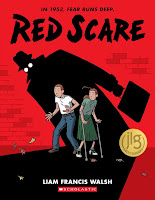April 5th 2022 by Graphix
E ARC provided by Edelweiss Plus
Peggy's family is struggling in 1953. Her father has come back from the Korean conflict badly injured, and their mother is cleaning rooms in a hotel. Peggy is recovering from polio, but the exercises are hard, and she is not doing them as much as she should. When she is helping her mother at work (actually, hiding out and reading a library book), she gets caught in a room when a guest enters. The man, whom we have seen earlier eluding the authorities with a mysterious briefcase, sees her briefly, but is later found dead. Peggy is questioned, and even though she and her mother don't know anything, the taint of having been near a "Commie" sticks to her, and bullies at school give her a hard time. Her twin brother Chip is also targeted. When Peggy is trying to escape from some of these bullies, her new neighbor arrives on her bike to rescue her, but the two try crossing the railroad tracks just as a train is approaching. It looks like they were hit, and their bike is found crushed, but the two are nowhere to be seen. This is because they have flown skyward. Peggy finds that the man at the motel has put a glowing red bar of some mysterious material in the tubing of her crutches, and this allows her to fly and also to walk unaided. She is grilled and followed by government agents, and at one point thinks she will turn the substance in to the FBI. Her new neighbor's family is accused of being Communists, and a group approaches their home to harm them. Peggy's father stands up to them. Will Peggy be able to solve the mystery of the substance and keep her family and friends safe?
Strengths: The 1950s are such an interesting period of history, yet there are so few books about it. Baby Boomers have really fallen down on the job writing about their childhoods'! It's helpful to read Walsh's notes at the back before diving into this science fiction graphic novel. He does a good job capturing the spirit of the comics at the time, and bringing in a film noir and 1950s sci fi vibe. This also had the most exciting scene I've ever scene in a graphic novel, and a lot of action and adventure, which can be hard to find in this format. Peggy's struggles with the aftermath of polio are well portrayed, and I would love to see an entire novel about a tween going through that experience. (Weber's Rosellen Kern has similar struggles, but eventually succumbs to the effects of the disease in the heart wrenching A Bright Star Falls, but that was written in 1959.)
Weaknesses: I was distracted by the fact that both Peggy and Chip looked like Tin Tin, and there were a couple of things that seemed historically inaccurate. Young readers will not have these problems.
What I really think: I was expecting this to be historical, so it took me a bit to get my mind around it. This was an interesting title, but definitely science fiction. I will probably buy this, but there was something about it that didn't sit quite right. Maybe the neighbor girl wearing jeans to school? Perhaps the fact that everyone I've talked to in Ohio did not have any experience with the Cold War affecting everyday life in Ohio. No one was turning in neighbors as Communists or having FBI agents descend on their neighborhoods. Maybe this was an East or West Coast thing?
Weaknesses: I was distracted by the fact that both Peggy and Chip looked like Tin Tin, and there were a couple of things that seemed historically inaccurate. Young readers will not have these problems.
What I really think: I was expecting this to be historical, so it took me a bit to get my mind around it. This was an interesting title, but definitely science fiction. I will probably buy this, but there was something about it that didn't sit quite right. Maybe the neighbor girl wearing jeans to school? Perhaps the fact that everyone I've talked to in Ohio did not have any experience with the Cold War affecting everyday life in Ohio. No one was turning in neighbors as Communists or having FBI agents descend on their neighborhoods. Maybe this was an East or West Coast thing?
Titles that address more realistic aspects of the homefront of the Cold War include Elliott's Suspect Red (2017), Avi's Catch You Later, Traitor (2015), Averbeck's A Hitch at the Fairmont (2015)Kidd's Year of the Bomb (2009) and Holbrook's The Enemy (2017), and the nonfiction titles Marrin's A Time of Fear (2021) and Brimner's Blacklisted (2018).
























No comments:
Post a Comment